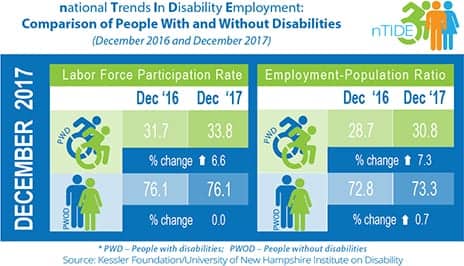Americans with disabilities continue to show strong gains in the labor market, according to the National Trends in Disability Employment—Monthly Update (nTIDE) for December 2017.
The upward trend, which began in the last quarter of 2016, has reached 21 consecutive months for this population, per the report, released by Kessler Foundation and the University of New Hampshire.
Through successful public-private partnerships, people with disabilities are finding competitive jobs in today’s job market. With funding from philanthropic organizations and private foundations, partnerships are being established that integrate recruitment, hiring, training, placement and support, toward the goal of connecting qualified candidates with job openings in government and private industry.
In the Bureau of Labor Statistics (BLS) Jobs Report released Friday, January 5, the employment-to-population ratio for working-age people with disabilities increased from 28.7% in December 2016 to 30.8% in December 2017 (up 7.3%; 2.1 percentage points). For working-age people without disabilities, the employment-to-population ratio also increased from 72.8% in December 2016 to 73.3% in December 2017 (up 0.7%; 0.5 percentage points). The employment-to-population ratio, a key indicator, reflects the percentage of people who are working relative to the total population (the number of people working divided by the number of people in the total population multiplied by 100), explains a media release from Kessler Foundation.
“A landmark has been achieved. Throughout 2017, we have seen improvement in the proportion of people with disabilities who are working,” says John O’Neill, PhD, director of employment and disability research at Kessler Foundation, in the release. “This solid year of employment growth shows that the efforts of people with disabilities striving to work are translating into success in the workplace.”
The labor force participation rate for working-age people with disabilities increased from 31.7% in December 2016 to 33.8% in December 2017 (up 6.6%; 2.1 percentage points). For working-age people without disabilities, the labor force participation rate remained that same at 76.1%. The labor force participation rate is the percentage of the population that is working or actively looking for work.
“These numbers are very encouraging,” statres Andrew Houtenville, PhD, associate professor of economics at UNH and research director of the Institute on Disability, in the release. “It appears that people with disabilities are finally recovering from the Great Recession. There remains, of course, a long way to go before people with disabilities approach the employment levels of people without disabilities,” he cautions.
[Source(s): Kessler Foundation, PRWeb]





